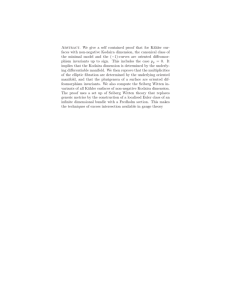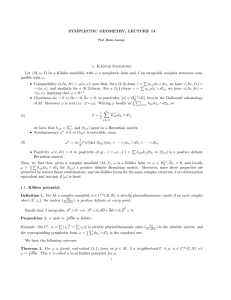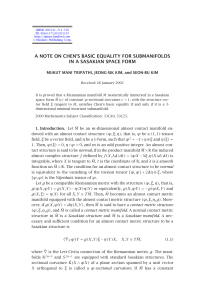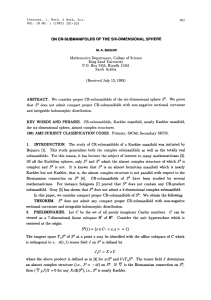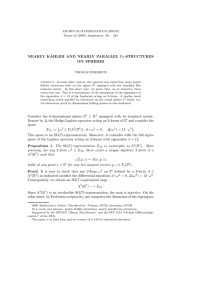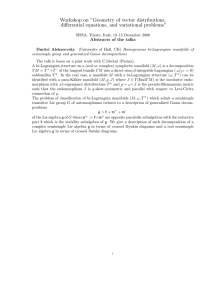ON TOTALLY REAL SUBMANIFOLDS IN A NEARLY K ¨ AHLER MANIFOLD
advertisement
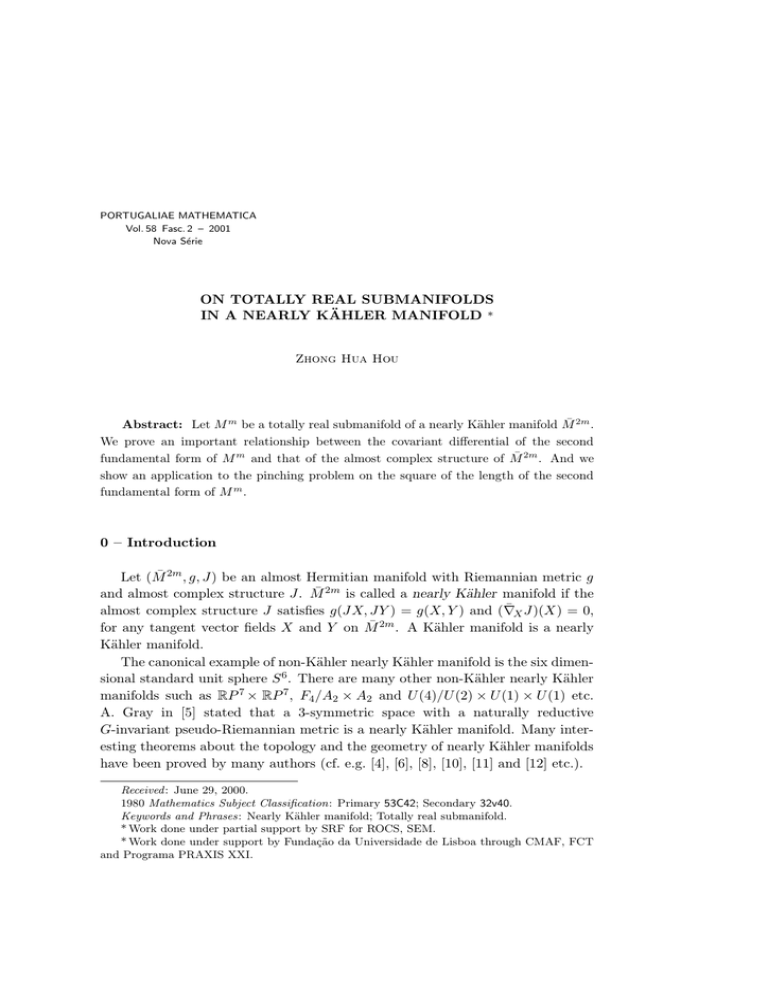
PORTUGALIAE MATHEMATICA
Vol. 58 Fasc. 2 – 2001
Nova Série
ON TOTALLY REAL SUBMANIFOLDS
IN A NEARLY KÄHLER MANIFOLD *
Zhong Hua Hou
Abstract: Let M m be a totally real submanifold of a nearly Kähler manifold M̄ 2m .
We prove an important relationship between the covariant differential of the second
fundamental form of M m and that of the almost complex structure of M̄ 2m . And we
show an application to the pinching problem on the square of the length of the second
fundamental form of M m .
0 – Introduction
Let (M̄ 2m , g, J) be an almost Hermitian manifold with Riemannian metric g
and almost complex structure J. M̄ 2m is called a nearly Kähler manifold if the
¯ X J)(X) = 0,
almost complex structure J satisfies g(JX, JY ) = g(X, Y ) and (∇
2m
for any tangent vector fields X and Y on M̄ . A Kähler manifold is a nearly
Kähler manifold.
The canonical example of non-Kähler nearly Kähler manifold is the six dimensional standard unit sphere S 6 . There are many other non-Kähler nearly Kähler
manifolds such as RP 7 × RP 7 , F4 /A2 × A2 and U (4)/U (2) × U (1) × U (1) etc.
A. Gray in [5] stated that a 3-symmetric space with a naturally reductive
G-invariant pseudo-Riemannian metric is a nearly Kähler manifold. Many interesting theorems about the topology and the geometry of nearly Kähler manifolds
have been proved by many authors (cf. e.g. [4], [6], [8], [10], [11] and [12] etc.).
Received : June 29, 2000.
1980 Mathematics Subject Classification: Primary 53C42; Secondary 32v40.
Keywords and Phrases: Nearly Kähler manifold; Totally real submanifold.
* Work done under partial support by SRF for ROCS, SEM.
* Work done under support by Fundação da Universidade de Lisboa through CMAF, FCT
and Programa PRAXIS XXI.
220
ZHONG HUA HOU
The geometry of submanifolds in an almost Hermitian manifold is a very active
topic in the theory of submanifolds. There have been many results on geometry
of submanifolds in a Kähler manifold.
The theory of submanifolds in a nearly Kähler manifold say M̄ 2m was studied
by many authors. Let M m be a totally real submanifold of M̄ 2m . Denote by Aξ
the shape operator on the tangent bundle T M of M in the direction of a unit
normal vector field ξ in the normal bundle N M . When M̄ is a complex space
form, Chen–Ogiue [1] proved that
AJX (Y ) = AJY (X) ,
for any two vector fields X and Y tangent to M . Ejiri [3] showed that the same
property holds for a 3-dimensional totally real submanifold in S 6 . In section 1,
we shall prove that the same property also holds for a totally real submanifold
in a nearly Kähler manifold.
We define a skew-symmetric tensor field G of type (1, 2) by
¯ X J) Y ,
G(X, Y ) = (∇
¯ is the Levi–Civita connection
where X and Y are vector fields on M̄ 2m and ∇
2m
on M̄ . Ejiri [3] proved that, for a 3-dimensional totally real submanifold M 3
in S 6 , G(X, Y ) is orthogonal to M 3 for any vector fields X and Y tangent to
M 3 . By applying this fact, he proved that such M 3 is orientable and minimal.
In section 2, we shall prove that, for any totally real submanifold M m in M̄ 2m ,
G(X, Y ) is orthogonal to M n for any vector fields X and Y tangent to M m .
Denote by σ the second fundamental form of M m . We proceed to show an
important relationship between σ and G. Precisely, we shall prove
Proposition 1.4. Let M m be a Lagrangian submanifold of a nearly Kähler
manifold (M̄ 2m , g, J). Let σ be the second fundamental form of M m . Define
¯ X J) Y for any
a skew-symmetric tensor field G of type (1, 2) by G(X, Y ) = (∇
m
¯ is the Levi–Civita connection
vector fields X and Y tangent to M , where ∇
with respect to g. Then
³
g ∇σ(X, Y, Z), JW
´
³
= g ∇σ(X, Y, W ), JZ
³
´
³
+ g σ(Y, Z), G(W, X)
− g σ(Y, W ), G(Z, X)
´
´
for any vector fields X, Y , Z and W tangent to M m .
As an application, we shall prove a pinching theorem on the square of the
length of the second fundamental form of a 3-dimensional totally real submanifold
M 3 in S 6 . Precisely, we shall prove the following
SUBMANIFOLDS IN A NEARLY KÄHLER MANIFOLD
221
Proposition 2.1. Let M 3 be a closed 3-dimensional totally real submanifold
of S 6 . Denote by S the square of the length of the second fundamental form of
M 3 . If S < 5/2, then M 3 is totally geodesic.
Remark 0.1. Simons [9] and Chern–do Carmo–Kobayashi [2] proved that,
for a closed n-dimensional minimal submanifold M n in an (n+p)-dimensional unit
sphere S n+p , M n is totally geodesic if S < n/(2−1/p). Moreover S = n/(2−1/p)
when and only when p = 1 or n = p = 2. A.M. Li and J.M. Li in [7] improved
this result. They proved that if p ≥ 2 and S < 2 n/3, then M n is totally geodesic.
Moreover, S = 2 n/3 when and only when n = p = 2. Therefore we wonder
whether or not this pinching constant could be improved when n ≥ 3 and p ≥ 2.
Proposition 2.1 give an affirmative answer to this expectation because 5/2 > 2 =
3 × (2/3).
1 – Geometry of totally real submanifolds in a nearly Kähler manifold
Let (M̄ 2m , g, J) be an almost Hermitian manifold with Riemannian metric
g and almost complex structure J. Let {e1 , e2 , ..., e2m } be a local orthonormal
frame field on the tangent bundle T M̄ 2m . Let {ω1 , ω2 , ..., ω2m } be its coframe
field and (ωab ) be the Levi–Civita connection form associated with this coframe
field. Then we have the Cartan structure equations:
(1.1)
¯
∇ea = ωab eb ;
dωa = ωab ∧ ωb ;
dωab = ωac ∧ ωcb + Ω̄ab ,
ωab + ωba = 0 ;
Ω̄ab + Ω̄ba = 0 ;
where (Ωab ) is the curvature form. The almost complex structure J of M̄ satisfies:
(1) J : Tx M̄ → Tx M̄ is linear;
(2) J(JX) = −X;
(3) g(JX, JY ) = g(X, Y );
for any X, Y in Tx M̄ . Under the above orthonormal frame field and associated
coframe field, J can be expressed as J = Jab ωa eb . In this case, J(X) = Jab Xa eb
for any X = Xa ea ∈ Tx M̄ . Moreover conditions (2) and (3) can be represented
by
(1.2)
Jac Jbc = δab ,
(1.3)
Jac Jcb = −δab ,
222
ZHONG HUA HOU
where (δab ) is the Kronecker symbol. From (1.2) and (1.3) we have
(1.4)
Jab + Jba = 0 .
Put J˜ = 21 Jab ωa ∧ ωb . From (1.4) it follows that J˜ is a 2-form which is called
the fundamental form associated the almost complex structure J.
The covariant differential of (Jab ), say (Jab,c ), is defined to be
(1.5)
¯ ab := Jab,c ωc = dJab + Jcb ωca + Jac ωcb .
∇J
It follows from (1.3) that
(1.6)
Jae,c Jeb + Jae Jeb,c = 0 .
Definition 1.1. (M̄ 2m , g, J) is called a nearly Kähler (or Tachibana) mani¯ of J satisfies (∇
¯ X J)(X) = 0 for any tangent
fold if the covariant differential ∇J
vector X.
¯ X J)(X) = 0 for any tangent vector X is equivalent
Remark 1.1. Equation (∇
to
(1.7)
Jab,c + Jac,b = 0 ,
for all a, b and c.
Let (M̄ 2m , g, J) be a nearly Kähler manifold. Let M m be a totally real submanifold, or a Lagrangian submanifold, of M̄ 2m . Then it follows that the image
of the tangent space Tx M m under the mapping of the almost complex structure
is the normal space Nx M m , at every point x ∈ M n . From now on, we agree on
the following index ranges:
1 ≤ a, b, c, ... ≤ 2 m ,
1 ≤ i, j, k, ... ≤ m,
and
i∗ = m + i for 1 ≤ i ≤ m .
Choose {e1 , e2 , ..., em ; e1∗ , e2∗ , ..., em∗ } to be a local orthonormal frame field of
the tangent bundle T M̄ 2m such that ei lies in T M m and ei∗ = Jei lies in N M m ,
for all 1 ≤ i ≤ m. We call such a kind of frame an adapted frame field on M̄ 2m .
Let {ω1 , ω2 , ..., ωm ; ω1∗ , ω2∗ , ..., ωm∗ } be the associated coframe field. Denote
(ωab ) to be the associated Levi–Civita connection form. Then (Jab ) can be expressed as
(1.8)
Jab =
δ ,
ij
a = i, b = j ∗ ;
−δij , a = i∗ , b = j ;
0,
otherwise .
SUBMANIFOLDS IN A NEARLY KÄHLER MANIFOLD
223
From (1.5) and (1.8), we infer
¯ i∗ j ∗ = ∇J
¯ ij = ωi∗ j + ωij ∗ ,
−∇J
(1.9)
¯ ij ∗ = ∇J
¯ i∗ j = ωi∗ j ∗ − ωij .
∇J
Restricting (1.1) to M n , we get ωk∗ = 0 for all k. The structure equations of
M n are
dωi = ωij ∧ ωj ;
Ωij = ωik∗ ∧ ωk∗ j + Ω̄ij ;
dωij = ωik ∧ ωkj + Ωij ;
(1.10)
dωi∗ j ∗ = ωi∗ k∗ ∧ ωk∗ j ∗ + Ωi∗ j ∗ .
Ωi∗ j ∗ = ωi∗ k ∧ ωkj ∗ + Ω̄i∗ j ∗ ;
From (1.1) we have the following relations:
ωij ∗ ∧ ωi = 0 ,
dωij ∗ = ωik ∧ ωkj ∗ + ωil∗ ∧ ωl∗ j ∗ + Ω̄ij ∗ .
Denote the curvature form (Ω̄ab ) by
(1.11)
1
R̄abcd ωc ∧ ωd .
2
Ω̄ab =
By Cartan’s lemma, we have
∗
∗
ωij ∗ = hjik ωk ,
(1.12)
∗
∗
hjik = hjki ,
∗
hlijk = hlikj + R̄l∗ ijk ,
∗
∗
where (hlijk ) is the covariant differential of (hlij ) defined by
(1.13)
∗
∗
∗
∗
∗
∗
∇hlij = hlijk ωk = dhlij + hlkj ωki + hlik ωkj + hsij ωs∗ l∗ .
The second fundamental form σ and its covariant differential ∇σ are defined by
(1.14)
∗
σ = hkij ωi ωj ek∗ ,
∗
∇σ = (∇hkij ) ωi ωj ek∗ .
From the first equation of (1.9) and (1.12) we derive
∗
∗
Jij,k = hjik − hijk .
(1.15)
It follows from (1.7) and (1.15) that
∗
∗
∗
∗
∗
∗
(1.16)
0 = Jij,k + Jik,j = hjik + hkij − 2 hikj ,
(1.17)
0 = Jjk,i + Jji,k = hkji + hijk − 2 hjik .
From (1.16) and (1.17), we derive
(1.18)
∗
∗
hjik = hijk
or
∗
∗
Jij,k = hjik − hijk = 0 .
224
ZHONG HUA HOU
It is known that the shape operator Aej ∗ of M m with respect to ej ∗ can be
∗
expressed as Aej ∗ (ei ) = hjik ek . From (1.18) we get the following
Proposition 1.1. Let M m be a totally real submanifold of a nearly Kähler
manifold M̄ 2m . Denote by Aξ the shape operator of M m with respect to a normal
vector field ξ of M m . Then
(1.19)
AJX (Y ) = AJY (X) ,
for any two vector fields X and Y tangent to M m .
Remark 1.2. When M̄ 2m is chosen to be the 6-dimensional unit sphere S 6
and M n is a 3-dimensional totally submanifold of S 6 , Ejiri [3] has proved (1.19)
in different way.
As an direct application of Proposition 1.1, we have the following
Proposition 1.2. Let M m be a totally real submanifold of a nearly Kähler
manifold M̄ 2m . Let {e1 , e2 , ..., em } be a local orthonormal frame field on M m .
∗
Denote Ai∗ = (hijk ) to be the coefficient matrix of Aei∗ for every i. Then
(1.20)
Tr
µX
A2i∗
i
¶2
=
X
(Tr Ai∗ Aj ∗ )2 .
i,j
Proof:
Tr
µX
i
A2i∗
¶2
=
X
i,j
∗
∗
∗
∗
hisk hikl hjlr hjrs =
X
∗
∗
∗
∗
hsik hlki hljr hsrj =
l,s
X
(Tr Al∗ As∗ )2 .
l,s
We define a skew-symmetric tensor field G of type (1,2) by
(1.21)
¯ X J) Y ,
G(X, Y ) = (∇
for any vector fields X, Y on M̄ 2m . Then G(ea , eb ) = Jab,c ec for any a and b.
Moreover it follows from (1.18) that
(1.22)
G(ei , ej ) = Jij,k∗ ek∗ ∈ N M m ,
for any i and j, which implies the following
225
SUBMANIFOLDS IN A NEARLY KÄHLER MANIFOLD
Proposition 1.3. Let M m be a totally real submanifold of a nearly Kähler
manifold M̄ 2m . Define a skew-symmetric tensor field G of type (1, 2) by G(X, Y ) =
¯ X J) Y . Then G(X, Y ) is normal to M for any two vector fields X and Y tan(∇
gent to M m .
∗
Let us consider the behavior of (hlijk ). From (1.9), (1.13) and (1.20) we infer
∗
∗
∇hlij = hlijk ωk
∗
∗
∗
∗
= dhlij + hlkj ωki + hlik ωkj + hkij ωk∗ l∗
∗
∗
∗
∗
= dhilj + hklj ωki + hilk ωkj + hikj ωk∗ l∗
∗
∗
∗
¯ k∗ i ) + hikj∗ (∇J
¯ k∗ l + ωkl )
= dhilj + hilk ωkj + hklj (ωk∗ i∗ − ∇J
∗
∗
∗
∗
∗
∗
∗
∗
= (dhilj + hikj ωkl + hilk ωkj + hklj ωk∗ i∗ ) − hslj Js∗ i,k ωk + hisj Js∗ l,k ωk
∗
= ∇hilj + hisj Js∗ l,k ωk − hslj Js∗ i,k ωk .
After sorting the above equality, we get
∗
∗
∗
∗
hlijk − hiljk = hsij Js∗ l,k − hslj Js∗ i,k .
(1.23)
It follows from (1.14), (1.22) and (1.23) that
³
g ∇σ(ek , ej , ei ), el∗
(1.24)
´
³
´
³
= g ∇σ(ek , ej , el ), ei∗ + g σ(ej , ei ), G(el , ek )
³
´
− g σ(ej , el ), G(ei , ek ) .
´
From (1.24) we have, for any X = Xk ek , Y = Yj ej , Z = Zi ei and W = Wl el ,
³
g ∇σ(X, Y, Z), JW
´
³
´
³
= g ∇σ(X, Y, W ), JZ + g σ(Y, Z), G(W, X)
³
´
− g σ(Y, W ), G(Z, X) .
Therefore we get the following
´
Proposition 1.4. Let M m be a Lagrangian submanifold of a nearly Kähler
manifold (M̄ 2m , g, J). Let σ be the second fundamental form of M m . Define
¯ X J) Y for any
a skew-symmetric tensor field G of type (1, 2) by G(X, Y ) = (∇
m
¯ is the Levi–Civita connection
vector fields X and Y tangent to M , where ∇
with respect to g. Then
(1.25)
³
g ∇σ(X, Y, Z), JW
´
³
´
³
= g ∇σ(X, Y, W ), JZ + g σ(Y, Z), G(W, X)
³
´
− g σ(Y, W ), G(Z, X) ,
for any vector fields X, Y , Z and W tangent to M m .
In the next section, we shall give an application to Proposition 1.4.
´
226
ZHONG HUA HOU
2 – A pinching problem on totally real submanifolds in S 6
In this section, we proceed to show an application of Propositions 1.1 and 1.4
to the theory of submanifold. Suppose that M̄ 2m is a nearly Kähler manifold of
constant curvature 1. Then the curvature tensor of M̄ 2m can be represented by
(2.1)
R̄abcd = δad δbc − δac δbd .
In this case, we have from (1.12) that
∗
∗
hlijk − hlikj = R̄l∗ ijk = 0 .
(2.2)
It is known that the Laplacian of hαij is
∗
∗
∗
∆hlij = hlijkk = (Tr Al∗ ),ij + (Ar∗ Al∗ Ar∗ )ij − (Tr Al∗ Ar∗ ) hrij
(2.3)
+ (Tr Ar∗ ) (Al∗ Ar∗ )ij − (Al∗ Ar∗ Ar∗ )ij + (Ar∗ Al∗ Ar∗ )ij
∗
− (Ar∗ Ar∗ Al∗ )ij + n hlij − (Tr Al∗ ) δij .
∗
Multiplying hlij on both-sides of (2.3) and taking sum with i, j and l, we derive
(2.4)
X
∗
∗
∗
hlij ∆hlij = hlij (n Hl∗),ij + (Tr Ai∗ ) Tr(Aj ∗ Aj ∗ Ai∗ ) + n S − (Tr Ai∗ )2
i,j,l
−
Xn
o
N (Ai∗ Aj ∗ − Aj ∗ Ai∗ ) + (Si∗ j ∗ )2 ,
i,j
∗
where we denote S = i,j,k (hkij )2 the square of the length of the second fundamental form of M n , Si∗ j ∗ = Tr(Ai∗ Aj ∗ ) and N (Ai∗ Aj ∗ −Aj ∗ Ai∗ ) = − Tr(Ai∗ Aj ∗ −
Aj ∗ Ai∗ )2 . Assume that M m is minimal in M̄ 2m . Then Tr Ai∗ = 0 for all i. And
(2.4) becomes
P
(2.5)
X
∗
∗
hkij ∆hkij = n S −
Xn
i,j
i,j,k
o
N (Ai∗ Aj ∗ − Aj ∗ Ai∗ ) + (Si∗ j ∗ )2 .
The Laplacian of S satisfies
(2.6)
X ∗
X
1
∗
∗
hkij ∆hkij .
(hlijk )2 +
∆S =
2
i,j,k
i,j,k,l
From now on, we assume M̄ to be the 6-dimensional unit sphere with the
standard induced metric from 7-dimensional Euclidean space R7 . It is known
that we can identify R7 with the set of all purely imaginary Cayley numbers.
227
SUBMANIFOLDS IN A NEARLY KÄHLER MANIFOLD
Then S 6 can be equipped with an almost complex structure by the cross product
of Cayley numbers. Moreover S 6 is nearly Kählerian but non-Kählerian. This
enables us to study the pinching problem on the square of the length of the
second fundamental form of 3-dimensional totally real submanifolds in S 6 in new
viewpoint.
The main technique is to give a lower estimate to the right-hand side of (2.6).
Up to now, the best estimation on the second part of the right-hand side of (2.5)
was given by A.M. Li and J.M. Li [7].
Lemma 2.1 (Li’s [7]). Let A1 , A2 , ..., Ap be symmetric n×n-degree matrices,
where p ≥ 2. Denote Sαβ = Tr(ATα Aβ ) and S = S11 + S22 + · · · + Spp . Then
Xn
(2.7)
N (Aα Aβ − Aβ Aα ) + (Sαβ )2
α,β
o
≤
3 2
S ,
2
where the equality holds if and only if one of the following conditions holds:
(1) A1 = A2 = · · · = Ap = 0;
(2) Only two of Aα ’s are different from zero. If we assume A1 6= 0, A2 6= 0
and A3 = · · · = Ap = 0, then S11 = S22 . Furthermore there exists an
orthogonal n×n-degree matrix U such that
U A1 U T =
s
1 0 0
S
.
0 −1 .. ,
4
0 ··· 0
U A2 U T =
s
0 1 0
S
..
1 0
. .
4
0 ··· 0
∗
In the rest of this section, we shall give a lower estimate to |∇σ|2= i,j,k,l (hlijk )2.
It is easy to see that JG(ei , ej ) lies in Tx M 3 and is perpendicular to ei and
ej for any i 6= j. So we can choose e1 , e2 and e3 such that (cf. Ejiri [3])
P
(2.8)
JG(e1 , e2 ) = e3 ,
JG(e2 , e3 ) = e1 ,
JG(e3 , e1 ) = e2 .
It follows from (2.8) that
(2.9)
J12,3∗ = J23,1∗ = J31,2∗ = −1;
and
Jij,k∗ = 0, otherwise .
∗
Fixing e1 and choosing e2 and e3 suitably, we can assume h123 = 0. Denote
(2.10)
∗
h112 = x1 ,
∗
h113 = x2 ,
∗
h122 = x3 ,
∗
h133 = x4 ,
∗
h223 = x5 ,
∗
h233 = x6 .
228
ZHONG HUA HOU
Then it follows from (1.18) that Ai∗ ’s can be expressed as
A 1∗
A 2∗
A 3∗
−x3 − x4
x1
=
x2
x1
x3
0
x1
= x3
0
x3
−x1 − x6
x5
x2
= 0
x4
0
x5
x6
x2
0 ,
x4
0
x5 ,
x6
x4
.
x6
−x2 − x5
And the square of the length of σ, say S, is expressed as
(2.12)
S = 4 (x21 + x22 + x23 + x24 + x25 + x26 ) + 2 (x3 x4 + x1 x6 + x2 x5 ) .
∗
Let us consider the representations of {hlijk }. Put
∗
h1122 = y2 ,
∗
h1113 = y6 ,
h1123 = y1 ,
(2.13)
h1233 = y5 ,
∗
h1133 = y3 ,
∗
h1223 = y7 .
∗
∗
∗
h1112 = y4 ,
∗
∗
∗
Since M 3 is minimal implies hl11k + hl22k + hl33k = 0 for any k, we have
∗
h1111 = −y2 − y3 ,
(2.14)
∗
∗
h1333 = −y6 − y7 .
h1222 = −y4 − y5 ,
So we have
(2.15)
X
∗
(h1ijk )2 =
X
∗
(h1iii )2 + 3
i
i,j,k
=
6 y12
+
4 (y22
X
∗
∗
(h1iij )2 + 6 (h1123 )2 =
i6=j
+
y32
+
y42
+ y52 + y62 + y72 ) + 2 (y2 y3 + y4 y5 + y6 y7 ) .
On the other hand, it follows from (1.23) that
∗
(2.16)
h2111 = y4 + x2 ,
∗
h2122 = −y4 − y5 + x5 ,
∗
h2112 = y2 ,
∗
h2113 = y1 + x4 ,
∗
h2123 = y7 + x6 ,
∗
h2133 = y5 − x2 − x5 .
Putting
∗
h2233 = y8 ,
(2.17)
∗
h2223 = y9 ,
then we have
(2.18)
∗
h2222 = −y2 − y8 ,
∗
h2333 = −x4 − y1 − y9 .
SUBMANIFOLDS IN A NEARLY KÄHLER MANIFOLD
229
Therefore we infer from (2.16), (2.17) and (2.18),
(2.19)
X
∗
X
(h2ijk )2 =
∗
(h2iii )2 + 3
i
i,j,k
X
∗
∗
(h2iij )2 + 6 (h2123 )2 =
i6=j
= 4 y12 + 4 y22 + 4 y42 + 6 y52 + 6 y72 + 4 y82 + 4 y92 + 2 y1 y9 + 2 y2 y8 + 6 y4 y5
+ 8 x4 y1 + (2 x2 − 6 x5 ) y4 − (6 x2 + 12 x5 ) y5 + 12 x6 y7 + 2 x4 y9
+ 4 x22 + 4 x24 + 6 x25 + 6 x26 + 6 x2 x5 .
By the same procedure, we obtain
∗
∗
h3111 = y6 − x1 ,
(2.20)
∗
h3112 = y1 − x3 ,
h3133 = −x6 − y6 − y7 ,
h3123 = y5 − x5 ,
∗
∗
∗
∗
∗
h3122 = y7 + x1 + x6 ,
h3223 = y8 ,
h3222 = y9 + x3 ,
h3113 = y3 ,
∗
h3233 = −y1 − y9 ,
∗
h3333 = −y3 − y8 .
Therefore we infer from (2.20) that
(2.21)
X
∗
X
(h3ijk )2 =
∗
(h3iii )2 + 3
i
i,j,k
X
∗
∗
(h3iij )2 + 6 (h3123 )2 =
i6=j
= 6 y12 + 4 y32 + 6 y52 + 4 y62 + 6 y72 + 4 y82 + 4 y92 + 2 y3 y8 + 6 y1 y9 + 6 y6 y7
− 2 x1 y6 + 2 x3 y9 + 6 x1 y7 + 6 x6 y6 − 6 x3 y1 + 12 x6 y7 − 12 x5 y5
+ 4 x21 + 4 x23 + 6 x25 + 6 x26 + 6 x1 x6 .
Denote F = |∇σ|2 . Then
F =
X
i,j,k,l
∗
(hlijk )2 =
X
∗
(h1ijk )2 +
i,j,k
X
i,j,k
∗
(h2ijk )2 +
X
∗
(h3ijk )2 .
i,j,k
It follows from (2.15), (2.19) and (2.21) that
F = 16 y12 + 8 y22 + 8 y32 + 8 y42 + 16 y52 + 8 y62 + 16 y72 + 8 y82 + 8 y92
+ 2 y 2 y3 + 2 y 2 y8 + 2 y 3 y8 + 8 y 1 y9 + 8 y 4 y5 + 8 y 6 y7
(2.22)
+ (8 x4 − 6 x3 ) y1 + (2 x2 − 6 x5 ) y4 − (6 x2 + 24 x5 ) y5
+ (6 x6 − 2 x1 ) y6 + (6 x1 + 24 x6 ) y7 + (2 x4 + 2 x3 ) y9
+ 4 x21 + 4 x22 + 4 x23 + 4 x24 + 12 x25 + 12 x26 + 6 x1 x6 + 6 x2 x5 .
230
ZHONG HUA HOU
It is not difficult to check that the only critical point of F with respect to
(y1 , y2 , ..., y9 ) is P0 = (y10 , y20 , ..., y90 ), where
1
(x3 − x4 ) , y20 = 0 , y30 = 0 ,
4
1
1
1
y40 = − x2 , y50 = (x2 + 3 x5 ) , y60 = x1 ,
4
4
4
1
1
y70 = − (x1 + 3 x6 ) , y80 = 0 , y90 = − x3 .
4
4
y10 =
(2.23)
Furthermore we can see that P0 is the minimum point of F . Substituting (2.23)
into (2.22) and recalling (2.12), we obtain the minimum value of F :
(2.24)
Fmin = 3 x21 + 3 x22 + 3 x23 + 3 x24 + 3 x25 + 3 x26
3
3
3
+ x5 x2 + x6 x1 + x3 x4
2
2
2
3
= S.
4
Therefore we get the following lower estimate to |∇σ|2 :
(2.25)
|∇σ|2 =
X
∗
(hlijk )2 ≥
i,j,k,l
3
S.
4
It follows from (2.5), (2.6), (2.7) and (2.25) that
(3.26)
∆S ≥ 3 S
µ
5
−S
2
¶
.
Inequality (3.26) implies the following
Proposition 2.1. Let M 3 be a closed 3-dimensional totally real submanifold
of S 6 . Denote by S the square of the length of the second fundamental form of
M 3 . If S < 5/2, then M 3 is totally geodesic.
ACKNOWLEDGEMENTS – The author is very grateful to Professor A. Machado for
his kind help and good advice. He would like to express his heartfelt gratitude to faculty
and staffs of CMAF/UL for their hospitality during his stay and study in Portugal.
And he wish to thank referee for his (her) earnest recommendation.
SUBMANIFOLDS IN A NEARLY KÄHLER MANIFOLD
231
REFERENCES
[1] Chen, B.Y. and Ogiue, K. – On totally real submanifolds, Trans. Amer. Math.
Soc., 193 (1974), 257–266.
[2] Chern, S.S.; Carmo, M.P. and Kobayashi, S. – Minimal submanifolds of a
sphere with second fundamental form of constant length, in “Functional Analysis
and Related Fields” (Proc. Conf. for M. Stone, Univ. Chicago, Chicago, Ill., 1968),
Springer-Verlag, New York, 1970, 59–75.
[3] Ejiri, N. – Totally real submanifolds in a 6-sphere, Proc. Amer. Math. Soc., 83(4)
(1981), 759–763.
[4] Gray, A. – Nearly Kähler Manifolds, J. Diff. Geom., 4 (1970), 283–309.
[5] Gray, A. – Riemannian manifolds with geodesic symmetries of order 3, J. Diff.
Geom., 7 (1972), 343–369.
[6] Gray, A. – The Structure of Nearly Kähler Manifolds, Math. Ann., 223 (1976),
233–248.
[7] Li, A.M. and Li, J.M. – An intrinsic rigidity theorem for minimal submanifolds
in a sphere, Arch. Math., 58 (1992), 582–594.
[8] Matsumoto, M. – On 6-dimensional almost Tachibana space, Tensor, N. S., 23
(1972), 250–252.
[9] Simons, J. – Minimal varieties in riemannian manifolds, Ann. of Math., 88 (1968),
62–105.
[10] Takamatsu, K. – Some properties of 6-dimensional K-space, Kodai Math. Sem.
Rep., 23 (1971), 215–232.
[11] Watanabe, Y. and Takamatsu, K. – On a K-space of constant holomorphic
sectional curvature, Kodai Math. Sem. Rep., 25 (1973), 297–306.
[12] Yamaguchi, S.; Chuman, G. and Matsumoto, M. – On a special almost
Tachibana space, Tensor, N. S., 24 (1972), 351–354.
Zhong Hua Hou,
Department of Applied Mathematics, Dalian University of Technology,
Dalian 116024, Liaoning – PEOPLE’S REPUBLIC OF CHINA
E-mail: zhhou@dlut.edu.cn
and
CMAF, Universidade de Lisboa,
Av. Prof. Gama Pinto, 2, 1649-003 Lisboa – PORTUGAL
E-mail: zhhou@lmc.fc.ul.pt
